This morning, our first off the ocean in a week, the room sways gently with the double swells born of long distance waves meeting the shore. There have been other landfalls during the trip that have seen us swerving drunkenly around restaurant tables, managing short chop in a marina shower (don’t close your eyes!) and swaying on island bedrock. It has often been a relief to get back on the boat. But now we are home, and it is time to regain landlegs and assess the challenges of T2’s first ocean voyage to determine her merits and needs.
For those who do not follow Jim Michalak’s Yahoo Group discussion, I commissioned Jim to draw me a design he called “Caroline” (I do feel honored), a combination of Philsboat and Frolic2. I had already built five boats of different types, but none were quite right. I grew up on the ocean, the daughter of a harbormaster, and I wanted a coastal cruiser – even though I now live in western Massachusetts. That meant I was looking for a trailer-sailer that did not weigh too much, as our RAV4 can only pull 1500 lbs. Yet a keel-less sailboat has a greater chance of capsize, hence my desire for both the slot-top cabin design and short seats in the middle of the boat to keep crew weight low on top of storage space for water ballast in orange juice jugs.
Jim and I started our conversations midsummer 2007, and I got the plans in November. “Caroline” was too big to build in the heated workshop I have off our open carport, so all winter and early spring I built pieces of her (the stations, the spars) and searched for gear (four anchors with rodes, sails, safety equipment, charts). I am blessed with some friends who enjoy meeting up once a week to build boats. However, I got it into my small brain that I wanted to use this boat for cruising the Maine coast in the summer of 2008, so early on in this project I started working at “Caroline” most weeknights and a lot of weekends. In April it was finally warm enough to move outside, and the hull took shape rapidly. Of course, the epoxy took its own lazy time curing in the cooler temps, but that was to prove a luxury I would fondly remember as the thermometer quickly soared. Looking back, I figure I had a space of a little under a month that had optimal temperatures for using epoxy.
| I got it into my small brain that I wanted to use this boat for cruising the Maine coast in the summer of 2008 |
 |
The pace of the build also rose from steady, to very involved, to absolutely insane by the time the pre-trip launch date neared. Two days before this launch, while tying the mizzensail onto the mizzenmast, I found I had made a rather large error. I had ordered the only Michalak mizzensail on the Duckworks site, only to realize way too late that Jim had drawn me a smaller mizzen than any of his previous designs. A quick check showed that at this point I would have to wait 90 days to order another sail. Another check of the still-to-do list showed that I was going to have to manage without a homemade mizzen, as there was too much else left to do. Even though Jim had wrote that the boat was balanced without the mizzen, this would prove to be a lack I would truly be sorry for.
She is called “T2” after my parent’s first shared boat, and the lady at the registry was really sweet to give me “MS 2008 CG” as my registration (Massachusetts Ship 2008 Caroline Gould). The registration numbers were painted on the bow the night before launch, and we cleaned up the drips from overnight dew the next morning. I borrowed lawnmower gas for the small two-stroke outboard I had bought off Craigslist, threw a tarp cover over the slot and headed down the road to the Connecticut River for launch only two hours later than planned. One mile down the road we stopped to recover the tarp that was blowing off and stowed it.
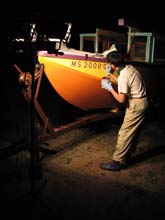 |
The registration numbers were painted on the bow the night before launch, and we cleaned up the drips from overnight dew the next morning. |
She was launched with a sprinkling of seltzer water, with cheers from friends and casual onlookers. As I had predicted, the first comments she got were for her paint job. Trust a quilter to come up with a color scheme including yellow, orange, lilac, purple and turquoise. The deck colors were chosen to be in a neutral range that neither reflected a lot of sun into the eyes nor absorbed too much heat to sit on. The yellow hull and orange bottom were for visibility (Maine lobsterboaters call kayaks “speedbumps”, and they have no regard for any pleasurecraft, no matter the rules of the road. I wanted to give them no cause to say they hadn’t seen me). The leeboard tips her balance to one side, but ballast easily corrects that.
What I found that launch day is that I LOVE to stand on a boat, and this one is so stable there has never been a problem. I had built a cookbox sized to fit T2’s aisle that I could stand on in the stern. I steer by manipulating the tiller with my feet and ankles while holding onto the aisle rails. Usually the mate sits on the front deck (so much for keeping crew weight low). But launch day brought only a puff of wind, so although we raised the sail once, we brought it down within a half hour as all we did was drift downstream. Motoring is a little clutzy, as all the controls are on the small outboard, but the best way to steer is to lock the motor forward and steer the boat with the tiller. Steering and say, shutting off the motor are not tasks that can be done simultaneously by one person, something that would prove challenging in docking situations.
| As I had predicted, the first comments she got were for her paint job. Trust a quilter to come up with a color scheme including yellow, orange, lilac, purple and turquoise. |
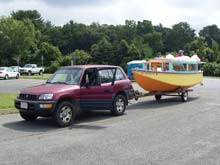 |
But I was pleased with the launch, with the boat, and with the short time away from the to-do list. Back into the fray for the two days remaining before Maine, hammocks and curtains were sewn, a trailer top was constructed, and lots of hardware was screwed down all over her. I stowed a full tool kit with all sorts of supplies because there was still a camping top to be built, and many systems had yet to be tested (sailing, sleeping, cooking, etc.).
We visited friends and watched the National Boatbuilding Challenge in Belfast, Maine, where teams of two compete to build the same boat the fastest, the best, or the worst. An oar snapped, but no one sank during the relay race, although there was a lot of water in some of those boats. Finally launch day number two arrived, and all my anxieties were back in force. We took some friends for a short champagne excursion around the outer Portland harbor, then bid goodbye and headed out for points unknown. You see, we had been building so furiously we hadn’t had time for route planning. And the sailing thing was still unsure, so we kept to motoring that first day, which limited our scope.
 |
We took some friends for a short champagne excursion around the outer Portland harbor, then bid goodbye and headed out for points unknown. |
The afternoon darkened, the winds took on a frenzied edge, and (of course) the small motor’s gas ran out in the middle of the bay. Luckily, perhaps due to the higher gas prices (or the high winds), few other boats were aiming towards us as I dangled over the dancing stern to fill the motor’s gas reservoir. With only a couple of meltdowns each we made it to a protected cove off of a MITA island (Maine Island Trail Association) only to find that the “Caroline” design does NOT like to point into the wind under any circumstances. The boat aggressively swings from side to side while at anchor. It is caused by wind pushing at a superstructure unbalanced by a deep keel or similar understructure. That first night, as the rains and thunderstorms moved in, all I could remember was that it was a problem I had read about, not the cause. But I did remember one solution denied me: the mizzensail. Even a small amount of sail in the aft part of the boat would have kept her pointed up into the wind. Due to my own wintertime inattention, I did not have that sail with me, so I had not even brought along the mizzenmast on which I could have rigged a replacement.
That night we tried one anchor, then two, then in desperation motored to an empty mooring ball. The rather violent swinging was bringing on seasickness in us both, even on the mooring. In the darkening light, between rain squalls, we spied a nearby beach and ran for it.
| That night we tried one anchor, then two, then in desperation motored to an empty mooring ball. The rather violent swinging was bringing on seasickness in us both, even on the mooring. |
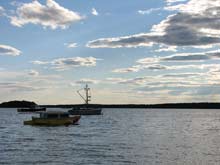 |
Relief! We grounded her and looked at our watches. As Maine has 10 foot tides, it would be 12 hours before we could get her off. We made some food, hooked up the hammocks, and slept.
We woke to a world tilted. Maine’s tides are really amazing, and a major factor in any cruise planning. At high tide the islands and waters seem normal and beautiful. Low tide is a very disconcerting reveal. It is a world of hard rocks and dark brown seaweed, and it MOVES all the time. The tide rises and lowers so fast that your surroundings change constantly. Charted and uncharted rocks appear and disappear, anchor rodes lengthen and shorten – and beached boats float onto shore or ground out at odd angles, waiting for the return of the tide.
Only, you see, the tides aren’t consistently 10 feet. And our next morning, as we ate breakfast and waited for the tide to float us again, I neglected to watch the time instead of the tide. It was a smaller tide, and we never did float. Some 30 minutes after high tide I glanced at my watch and realized in horror that we had but seconds to spare before we were trapped for another 12 hours. A quarter hour of hard physical labor later, we rocked the boat back into the small cove and collapsed in exhaustion. You’d think it would be a rather indelible lesson. In fact it happened yet another time later in the trip even after setting a stern anchor to hold us out from shore. Those tides move fast.
But we did get to sail that day, and she does sail well. The downhaul is flukey – difficult to place and difficult to use. But I used a rope traveler between stern cleats, which meant that handling the big mainsheet took little power or strength. I fiddled with my GPS, and I do believe we got up to 7.6 mph in 10 knot winds. We didn’t have much upwind work that day, but I was reassured that she will turn through the wind quite quickly, and that gybes with the lug sail are not as scary as with other rigs.
Beaching her for the night worked once, why not again? We found another MITA island and did just that. We spent some time that evening cobbling together the camping top. We brought four PVC hoops preshaped to fit the aisle, then added polytarp over and bug net draped at the ends. How wonderful to be able to walk upright in the cabin. My partner kept testing the height of the permanent cabin top with her head, but has to report that it stayed the same throughout the trip, regardless of the number of times she tested it.
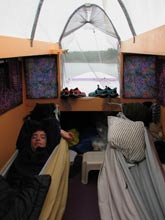 |
We spent some time cobbling together the camping top. We brought four PVC hoops preshaped to fit the aisle, then added polytarp over and bug net draped at the ends. How wonderful to be able to walk upright in the cabin. |
The cabin is amazing: large, airy, and pleasant. Safe from rain and bugs well, I’ve never had camping so good. The hammocks were really comfortable (that is a whole different, long story from years of building, testing, and using them), and I got the longest and best nights of sleep I have had in months.
Yet there were constant challenges. T2 would not point up into the wind and stay there while we worked to set up the sail. Only by using the motor could we stay head to wind to set, reef, or remove sail – a really dangerous situation as the winds arose in the afternoon. Again, the mizzensail to the rescue – or not, due to my mistake. We finally took to using the sail only in carefully chosen moments, and motored the rest of the time. Taking a break was difficult. We couldn’t anchor without getting seasick from the swaying, we couldn’t beach without constant vigilance, and floating dockspace was at a premium. We stayed one night at a B&B and left T2 on a mooring to swing without passengers. We ate a couple of times at restaurants just because we could tie up at their docks for awhile. We stopped on some beaches but could not stray far for need of adjusting anchors. Sometimes we just stopped mid-bay, but then we always had to be on the lookout for lobster buoys and boats, which are everywhere. We were pushed at by winds, by tides, and by powerful river currents dissipating slowly into the sea.
| We ate a couple of times at restaurants just because we could tie up at their docks for awhile. |
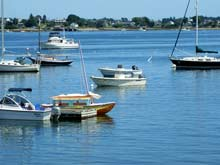 |
And on our last day, yesterday, we awoke to thick fog. Really, really thick. Changing, moving, now revealing, now hiding. We hugged the shore when we could, and made two short hair-raising passages through gray nothingness to get back to Portland. The chart, GPS and binoculars were essential.
Now T2 sits trailered on the car in the driveway. We made a huge to-do list on the ride back, the most important point being the construction of a homemade mizzensail before we head out again in two weeks. I know the room will stop swaying in a day or two, which is good, because right now any seams would look really drunk.
Despite the mizzen problems and the new to-do list, I really like the “Caroline” design. She is seaworthy, stable, and she takes waves and huge ferry wakes without a problem. I’ll get her to sail and anchor well. These things just take time. I send out a warm thank you to Jim Michalak, Yvonne, Shirley, Patricia, April, Steve, and a large number of other friends who helped in one way or another.
Caroline Gould
|

